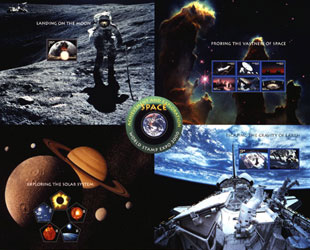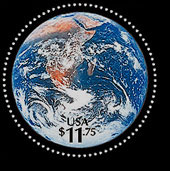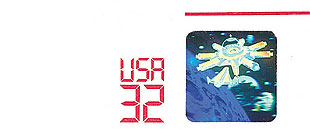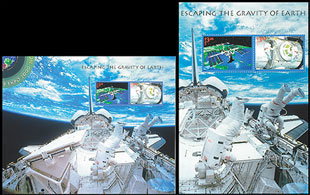|
|

|
This is an edited version of a Linn's article that appeared in the June 26, 2000, issue of Linn's Stamp News. For the complete story, subscribe to Linn's Stamp News. It is reprinted here with permission.
Space hologram to open Expo
by Michael Baadke
The first of 15 new high-value Space Achievement and Exploration postage stamps will be issued by the United States Postal Service July 7, the opening day of World Stamp Expo 2000 in Anaheim, Calif. Four of the 15 stamps will include holographic design elements.
The other 14 Space stamps will be issued over the course of the next four days, culminating with the July 11 release of the uncut Space Achievement press sheet containing all 15 stamps, shown here.

Before that final issue appears, however, collectors will be offered five individual souvenir sheets created from sections of the full sheet, which is being manufactured with moisture-activated adhesive. Each souvenir sheet will contain from one to six stamps. The combined face value of all 15 stamps is $38.50. Collectors who want to obtain one each of the five souvenir sheets and the uncut sheet of 15 will spend $77.
The Postal Service has manufactured 2 million Space Achievement sheets: 1.695 million will be divided into individual souvenir sheets, and the remaining 305,000 will be offered as uncut sheets. Orders are now being accepted without quantity limitations by USPS Stamp Fulfillment Services.
However, in a May press release, the Postal Service pointedly stated, "To prevent large orders of the Space Achievement and Exploration stamps, followed by subsequent returns of large quantities of stamps not sold in the after market, there will be no refunds. Damaged or flawed items will be handled under the postal exchanges and returns policy described in the USA Philatelic catalog." Orders will be fulfilled only after the stamps have been issued.
The five souvenir sheets will be issued one per day during the first five days of the show, which runs from July 7 to 16 at the Anaheim Convention Center. As reported on page 2 of the March 6 Linn's Stamp News, the Space Achievement stamps will be available for purchase at the show in Anaheim, by mail-order from USPS Stamp Fulfillment Services, and at postal stores and philatelic centers nationwide. The stamps are not expected to be available at standard post office windows.
 The July 7 issue will mark three firsts for the U.S. Postal Service: its first hologram postage stamp, its first round stamp, and its first round souvenir sheet. The $11.75 round stamp depicts a view of Earth from space, with the North American continent centered in the upper part of the globe. The July 7 issue will mark three firsts for the U.S. Postal Service: its first hologram postage stamp, its first round stamp, and its first round souvenir sheet. The $11.75 round stamp depicts a view of Earth from space, with the North American continent centered in the upper part of the globe.
The planet is rendered as a hologram, a silvery image with rainbow highlights that conveys the effect of a three-dimensional image on a two-dimensional surface. A split coherent beam of laser radiation is used to create a pattern of interference from which the 3-D holographic image is reproduced. According to USPS, the "astounding holographic animation of the Earth" will allow the viewer to see the planet rotate 25 degrees east and west.
The United States has previously issued four stamped envelopes with holographic stamp designs affixed. Each envelope includes a patch that shows through a window in the envelope. A design depicting an orbiting space station was used three times: on a 25¢ envelope in 1989, a 29¢ envelope in 1992, and a 32¢ envelope in 1995. The imprinted stamp and hologram of the 32¢ envelope are shown nearby.

A 25¢ envelope showing football players and the Vince Lombardi trophy was issued in 1990. More than 20 countries around the world have created stamps or postal stationery with holographic designs since the first hologram stamp was issued by Austria in 1988.
The $11.75 Earth stamp matches the rate for an Express Mail package weighing up to 8 ounces. The 3.65-inch round souvenir sheet includes the 1.78-inch round Earth stamp in the middle, surrounded by perforations and a wide dark ring, which changes into a green outer ring bearing two lines of text: "SPACE ACHIEVEMENT AND EXPLORATION" around the top, and "WORLD STAMP EXPO 2000" around the bottom.
July 8 will see the release of a second $11.75 hologram stamp, this one rectangular and depicting a model of the U.S. lunar lander just above the surface of the moon. The lander is represented as a hologram, based on computer and 3-D models from NASA. The moon is shown twice on the same stamp: acting as the base for the lander and rising beyond the horizon in the background of the design.
The stamp is large, 1.96 inches across by 1.41 inches high, approximately two-thirds the size of the 1997 $3 Mars Rover Sojourner stamp. It will be sold in a souvenir sheet of one. The souvenir sheet measures 7.25 inches horizontally and 5 inches vertically. The selvage shows an April 1972 photograph of Apollo 16 lunar module pilot Charles M. Duke Jr. on the moon collecting lunar samples at the rim of Plum crater near the Descartes landing site. The photo, looking eastward, was taken by mission commander John W. Young. Lettering on the sheet to the left of Duke reads "LANDING ON THE MOON."
Each of the four rectangular souvenir sheets from this issue shows only part of a larger image from the full uncut sheet of 15 stamps. On the full sheet, for example, the Lunar Roving Vehicle can be seen in the left background of the NASA photo of Duke, but it has been cropped from the souvenir sheet.

The two remaining hologram stamps in the set will be issued July 9, adjacent to each other on one souvenir sheet with denominations of $3.20 each. Titled "ESCAPING THE GRAVITY OF EARTH," the vertically oriented souvenir sheet shows in its selvage astronauts David Leestma and Kathryn Sullivan in space, working in the open cargo bay outside the shuttle Challenger during mission STS 41-G in October 1984. A view of Earth fills the upper half of the scene.
The design on the stamp at left represents a space shuttle docking with the orbiting international space station. It is based on a computer-generated NASA image. The stamp at right shows a closer view of two astronauts at work outside the space station, from a NASA artist's conception. The stamp sizes are each the same as the $11.75 Landing on the Moon stamp. The $3.20 denomination pays the domestic Priority Mail rate for items up to two pounds.
Six 60¢ stamps picturing various observatories and telescopes will be issued July 10 in a single horizontal souvenir sheet titled "PROBING THE VASTNESS OF SPACE." The backdrop of the sheet pictures a wider view of the Eagle nebula that appeared on a 33¢ stamp in the Edwin Powell Hubble set issued April 10.
Each of the six stamps bears a small inscription that describes the scene depicted: "2.4-meter Optical Telescope, NASA's Hubble Space Telescope, Earth Orbit," "Radio Interferometer, NSF's Very Large Array, New Mexico," "Twin 10-meter Optical and Infrared Telescopes, Keck Observatory, Hawaii," "Optical Telescopes, NSF's Cerro Tololo Inter-American Observatory, Chile," "100-inch Optical Telescope, Mount Wilson Observatory, California," and "305-meter Radio Telescope, NSF's Arecibo Observatory, Puerto Rico."
The 60¢ stamps each measure 1.56 inches by 0.99 inches, the same size as the 60¢ Grand Canyon stamp issued Jan. 20. The 60¢ denomination meets the rate for overseas mail of one half-ounce or less.
On July 11 the Postal Service will issue both the final souvenir sheet, "EXPLORING THE SOLAR SYSTEM," and the full press sheet of 15 stamps. With a fanciful backdrop of Earth's moon, Saturn and an array of stars, the final souvenir sheet contains five $1 stamps depicting various views of the sun.
Each stamp has five equal sides, forming the first pentagonal postage stamps ever issued by the United States. Each side measures 0.8125 inches.
The five designs show the sun's corona during an eclipse, from a satellite photograph by Dan McCoy; a cutaway view of the sun and its interior by artist Jim Lamb; a digitally restored NASA image of sunrise from space; an image of a spectacular solar eruption acquired from the Skylab space station Dec. 19, 1973; and a photo from Earth of the sun in a partly cloudy sky, by photographer Craig Aurness.
All of the Space Achievement stamps were manufactured under contract with Sennett Security Products of Chantilly, Va. The stamps were printed by American Packaging Corp., of Columbus, Wis., and processed at Unique Binders, Fredericksburg, Va.
The stamps were gravure-printed with holographic elements. Multicolor gravure printing is accomplished with etched printing cylinders, one for each ink, that transfer the inked recess images directly to the stamp paper.
The Postal Service will not offer first-day covers for the Space Achievement issue. Collectors wishing to prepare their own first-day covers may do so using the addresses and instructions provided with the technical details in the box below.
First-day cancel ordering information
Standard ordering instructions apply. Collectors are encouraged to purchase their own stamps and affix them to envelopes. Envelopes should be addressed for return and placed in a larger envelope addressed using all capital letters and no punctuation, except the hyphen in the ZIP+4 code.
Because the 15 stamps are issued on five different days, they must be properly addressed to receive the appropriate first-day cancel. The first line of the address should read: "Space Achievement and Exploration Commemorative Stamp" (for the $11.75 round stamp), "Landing on the Moon" ($11.75 rectangular), "Escaping the Gravity of Earth" ($3.20), "Probing the Vastness of Space" (60¢), or "Exploring the Solar System" ($1). The address is otherwise the same: Postmaster, 701 N. Loara St., Anaheim, CA 92803-9991.
The Postal Service also offers a first day address for the uncut sheet, to be addressed "Space Achievement and Exploration Uncut Press Sheet," using the Anaheim mailing address.
All requests for first-day cancels must be postmarked by Aug. 7 (for either $11.75 stamp), Aug. 8 ($3.20), Aug. 9 (60¢), or Aug. 10 ($1 and uncut sheet).
|
back to News

© 2023 collectSPACE.com All rights reserved.
Questions? E-mail contact@collectspace.com

|
|

|

|
